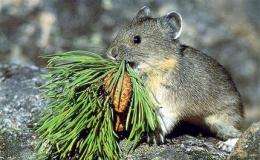FILE - This undated photo released by the U.S. Geological Survey, shows a mountain-dwelling American pika. The American pika, a short-legged, softball-sized fur ball that often huddles in high mountain slopes, isn't built for long-distance travel. So as the West's climate warms, the tiny pika has little choice but to scurry a little farther up slope to beat the heat. (AP Photo/US Geological Survey, File)
(AP) -- A tiny mammal that can't handle warm weather could become the first animal in the lower 48 states to get Endangered Species Act protection primarily because of climate change.
The U.S. Fish and Wildlife Service, responding to a petition from environmentalists, said Wednesday that it will launch an in-depth review of the American pika and submit findings by Feb. 1, 2010.
The agency acknowledged that there's "substantial information" indicating that climate change may threaten the pikas' habitat and range.
"The service knows that climate change is real. It is the biggest conservation challenge of our time," said Diane Katzenberger, a Fish and Wildlife spokeswoman in Denver.
The pika - a furry, big-eared relative of the rabbit - dwells mostly in high, rocky mountain slopes in 10 Western states.
It is well-suited for alpine conditions, with dense fur, slow reproductivity and a thermal regulation system that doesn't do well in the heat. Even brief exposure to temperatures of 78 degrees or warmer can cause death.
As the West warms, scientists say some pikas have tried to move upslope to find cooler refuges but have run out of room.
Any steps taken to protect the pika could also help other species affected by climate change, said Greg Loarie, an attorney with Oakland, Calif.-based Earthjustice who has worked on pika lawsuits pressing for protections.
"The pika is the fire alarm and this is our opportunity to come to grips with global warming and prevent an extinction crisis," Loarie said.
Extending federal protections to the pika primarily because of climate change would likely lead to larger policy discussions about how best to mitigate those effects. Environmentalists say the pika listing should be part of a sweeping movement to curb emissions that most climate scientists say is contributing to global warming.
Katzenberger said Fish and Wildlife is in the midst of developing a five-year plan on how it will deal with climate change.
The Bush administration listed the polar bear as a threatened species in 2008, the first to be protected because of the threats of global warming. Officials quickly completed regulations, though, to ensure the listing couldn't be used to block projects that contribute to global warming. That decision is now being challenged in court.
The pika lives in parts of California, Colorado, Idaho, Montana, Nevada, New Mexico, Oregon, Utah, Washington and Wyoming.
A study in 2003 found six of 25 previously known pika populations in the Great Basin had disappeared, primarily because of the effects of warming temperatures.
Shaye Wolf, a biologist with the Center for Biological Diversity, the environmental group that petitioned to have the pika protected, said subsequent studies indicate other populations in the Great Basin have disappeared. Formal results of those follow-up studies have not been published.
---
On the Net:
©2009 The Associated Press. All rights reserved. This material may not be published, broadcast, rewritten or redistributed.



















